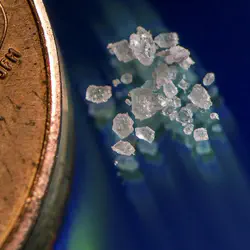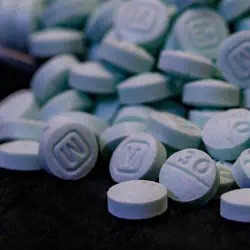DRUGS: WHAT YOU
NEED TO KNOW Booklet

Signs and Symptoms of Addiction to Fentanyl and Its Analogs

Courtesy of DEA.gov
Fentanyl has long been a powerful opioid in medical use for the most severe types of pain. It was often administered as an injection, as part of a formula for anesthesia, or in lozenge or patch form. Its use is tightly controlled because of the drug’s strength and the potential for overdose.
For years, the only supplies of fentanyl available to those who abused drugs were pilfered from medical facilities, such as a medical staffer who would drain a bottle of injectable fentanyl and refill the bottle with water, or an aide in a nursing home would steal fentanyl patches and squeeze out any remaining medication.
When illicit drug manufacturers discovered the immense profits available from making and trafficking fentanyl, everything changed. In a short time, powerful and deadly illicitly-manufactured fentanyl began to be found in drug supplies across America.
Fentanyl and Dozens of Analogs
While there is a drug called fentanyl, there are also dozens of chemically similar drugs. These are referred to as analogs, a word that refers to the structural and functional similarity of different drugs. According to the Drug Enforcement Administration, some of the fentanyl analogs found on the illicit market include:
- Alphamethylfentanyl
- 3-methylthiofentanyl
- Acetyl-alpha-methyl fentanyl
- Beta-hydroxy-3-methylfentanyl
- Alpha-methylthiofentanyl
- Thiofentanyl
- Betahydroxyfentanyl
- Para-fluorofentanyl
- 3-methylfentanyl
- Carfentanil
Analogs vary only slightly from the original formula for fentanyl, perhaps just the realignment or addition of a few molecules. All are synthetic drugs, which means they are made in labs and do not rely on opium poppy crops in a far-off land. Because they are all synthetic opioids, they have very similar effects to those of oxycodone, hydrocodone, opium, heroin, morphine and other opioids.
Fentanyl is cheap to manufacture, and because it is so potent, a single dose is incredibly tiny. A single pound of fentanyl smuggled into the country can be broken up into hundreds of thousands of doses for those addicted to this drug.
Fentanyl itself is ten times stronger than heroin. Some of these formulas are dozens of times or hundreds of times stronger than heroin which makes them incredibly deadly. 1,2
Fentanyl Hiding in Our Illicit Drug Supplies

Courtesy of DEA.gov
Many people overdosing on fentanyl never intended to buy this drug. They intended to buy OxyContin, Xanax, Adderall or perhaps heroin. But they went to the illicit market for their pills, or they asked their drug dealer for heroin. On the illicit market, counterfeit pills and heroin supplies often contain fentanyl. Even cocaine and methamphetamine may have fentanyl added to them.3
If a person is not accustomed to using strong opioids, a single pill could cause a fatal overdose. Or the heroin dose they are accustomed to taking could end their life if it contains fentanyl. It is a far more dangerous world for a drug user than it ever has been. The Drug Enforcement Administration laboratory found that 26% of counterfeit pills seized on the illicit market contained a lethal dose of fentanyl.
Symptoms of Fentanyl Addiction
All forms of fentanyl are strong opioids; therefore, the symptoms of fentanyl addiction will match those of opioid addiction. A person addicted to fentanyl will exhibit these signs:
- Relaxation
- Lethargy
- Euphoria
- Sedation
- Dizziness
- Nausea
- Vomiting
- Itching
- Tiny pupils
The most dangerous symptom of fentanyl addiction is respiratory depression. This means that fentanyl and its analogs all slow breathing. If breathing slows enough, a person’s oxygen levels will drop, which can cause brain damage. In a fatal overdose, the person stops breathing completely.
Many lives have been saved from fentanyl overdoses by the administration of the opioid antidote naloxone. While a heroin overdose normally requires a single dose of naloxone to bring a person back to consciousness, a fentanyl overdose can require several doses to reverse the effect of this powerful opioid.
Health Effects of Fentanyl Addiction
Fentanyl is very hard on the body. Taking just a little too much fentanyl into the body can result in:
- Pneumonia
- Fluid buildup in the lungs
- Muscle tissue breakdown
- Brain injury
- Kidney failure
- Cognitive injuries
A person who intentionally or unintentionally consumes fentanyl needs help to quit using drugs at the first moment possible to stay safe and perhaps save their own life.4
Overdose Symptoms
As a person struggles to breathe while they are in the midst of an overdose, they may gasp or snore loudly. Additionally, these signs are likely to be present:
- Stupor
- Unresponsiveness
- Pinpoint pupils
- Blue lips or fingernails
- Cold, clammy skin
- Coma
- Fentanyl Withdrawal

Any opioid withdrawal process is painful and difficult to complete, which makes good supervision and support very important for a person kicking this drug. They are likely to experience:
- Deep muscle and bone pain
- Insomnia
- Diarrhea
- Vomiting
- Stomach cramps
- Increased blood pressure
- Chills
- Restless, jerking legs
- Severe cravings
The worst of the withdrawal process will be complete for most people in about a week, although there can be lingering effects that last much longer.
The Need to Get Help Quickly
With fentanyl contaminating illicit drug supplies and being shaped into counterfeit pills, it has never been more important to get help for a person who is addicted to any drug. Even if they have used cocaine exclusively and been able to survive, a single dose of fentanyl added to their cocaine could end their life immediately.
There is truly no time to waste, no time to let a person “hit rock bottom.” Recovery is needed now.
Sources:
-
Drug Enforcement Agency. “Fentanyl.” DEA, 2020. DEA Publication (PDF) ↩︎
-
Drug Enforcement Agency. “Drugs of Abuse.” DEA, 2020. DEA Publication (PDF) ↩︎
-
Drug Enforcement Agency. “Counterfeit Pills.” DEA. DEA Publication (PDF) ↩︎
-
Health and Human Services. “Non-Fatal Opioid Overdose and Associated Health Outcomes: Final Summary Report.” HHS, 2019. HHS Article ↩︎


